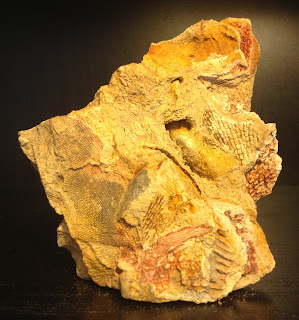Hi There Stranger!
Welcome to my blog!
Simply put this is a blog to showcase my fossil collection.
I
have an avid interest and am currently focusing my studies on
palaeontology and museum studies. My main area of interest at the moment
is in the Cambrian explosion but I am also curious about mass
extinction events.
My small (for now) collection features fossils from the Hunter Valley near Newcastle, New South Wales, Australia.
Hope you enjoy!
Permian Fossils of the Hunter Valley
A Collection of Fossils
Thursday 1 November 2012
Background
The
fossils in my collection were collected on field trips in 2009 and 2012 from
Mulbring Quarry near the township of Mulbring and Aberdare State Forest near
Cessnock. The fossils were lawfully acquired with permission of private
property owners as organised by the field trip
coordinators.
There was also extensive volcanism along the east coast of Australia. Evidenced at the fossil localities by the volcanic striated drop stones. Large inland seas also dominated parts of the continent at this time. The fossils in my collection are all marine specimens typical of shallow marine environments.
Excursion Handout Permian fossils and palaeoenvironments of the Hunter Valley
Monroe, M.H. 2008. The Permian Period 286-245 Ma. In http://austhrutime.com/permian_period.htm. Accessed 30.10.12.
Percival, I.G. 1979. The geological heritage of New South Wales, volume 1. Geological Society of Australia, Sydney.
The fossil specimens date from the Middle Permian ~250 Ma and are located
in the Fenestella Shale which forms part of the Branxton Formation, Maitland
Group, lower Hunter Valley. Both localitites feature exquisite examples of marine Permian fauna.
Australia
250 Ma was
located in the south polar region and was part of the Gondwana
supercontinent which consisted of present day South America, Africa,
India, Australia, New Zealand and Arabia. At this time the climate was
cool temperate with pockets of glaciation and annual ice covering and
also pockets of forests full of diverse flora. Both fossil sites contain
evidence of glaciation and frequent ice covering with the presence of
drop stones and wood debris found at both sites.
Figure showing the change in position of the South Pole throughout the Paleozoic. Source: http://www.ncdc.noaa.gov/paleo/ctl/cliscibeyond.html
There was also extensive volcanism along the east coast of Australia. Evidenced at the fossil localities by the volcanic striated drop stones. Large inland seas also dominated parts of the continent at this time. The fossils in my collection are all marine specimens typical of shallow marine environments.
References
Monroe, M.H. 2008. The Permian Period 286-245 Ma. In http://austhrutime.com/permian_period.htm. Accessed 30.10.12.
Percival, I.G. 1979. The geological heritage of New South Wales, volume 1. Geological Society of Australia, Sydney.
Aberdare State Forest Fossils 2012
Here are the fossils which I collected from Aberdare State Forest in 2012. Identifying species is more difficult in these specimens as they are not as well preserved as the Mulbring Quarry specimens.
Specimen 5: Aberdare State Forest. Contains Gastropods, Bivalves species Edmondia(?) and other species difficult to discern.
Specimen 6: Aberdare State Forest. Weathered surface. Contains Gastropods species Keenia, Bivalves and Brachiopods.
Specimen 7: Aberdare State Forest. An intact Chaenomya Bivalve.
Specimen 8: Aberdare State Forest. Contains Gastropods, Bivalves and drop stones. Species difficult to distinguish.
Specimen 9: Aberdare State Forest. Contains Gastropods, Bivalves and drop stones. Species difficult to distinguish.
Mulbring Quarry Fossils 2012
Here are the fossils which I collected from Mulbring Quarry in 2012 and my attempt to identify the species contained in the specimens.
Specimen 1: Freshly exposed side. Mulbring Quarry. Contains Bryozoans species Fenestella and Polypora, Brachiopods species Martinopsis, Trigonotreta and others, Bivalves.
Specimen 1: Weathered side. Mulbring Quarry. Contains Brachiopod species Trigonotreta and Bivalve species Chaenomya. Also preserves Bryozoans, Crinoid stems and Bivalves not distinguishable in this photo.
Specimen 2: Side 1. Mulbring Quarry. Contains Crinoid stems, Bryozoan species Fenestella and Polypora, Brachipod Martinopsis and possibly another (unknown species), bivalve species unkown, and a possible Lepidodendron fragment.
Specimen 2: Side 2. Mulbring Quarry. Contains Crinoid stems, Bryozoans species Fenestella and Polypara and a possible Trilobite.
Specimen 3: Mulbring Quarry. Contains Bryozoans Fenestella and Polypora, Crinoid stems, Brachiopods species unknown and Bivalves speciies unknown.
Specimen 4: Mulbring Quarry. Contains an abundance of Bryozoan Fenestella and Polypora.
Aberdare State Forest
The fossil site in the Aberdare State Forest is a fairly recent discovery located near Cessnock. Therefore, unfortunately, no academic research has been completed about the site. However, Macquarie University staff have carried out some analysis of the site.
There is less of an abundance of species at this site compared to Mulbring Quarry but
gastropods, bivalves and brachiopods are the most commonly found fossils. Fragments of bryozoans
and Crinoidea stems are also found but are far less common.
The
lithology is different to Mulbring Quarry in that it consists of fine to course
grained sandstone. The preservation of the fossils however is the same as at Mulbring (casts and moulds). There are also drop
stones and large chunks of fossilised wood indicating that this site also
experienced frequent glaciation events. The environment of deposition was much
more turbulent than Mulbring owing to the fragmentary remains of the bryozoans
and crinoid stems. The size of the wood debris and drop stones is also larger and
they occur more frequently than at Mulbring. This infers that the site was located fairly close to the coast compared to the Mulbring Quarry site which was located further inland during the Middle Permian.
References
Excursion Handout. 2012. Permian Fossils and Palaeoenvironments of the Hunter Valley.
Subscribe to:
Posts (Atom)











